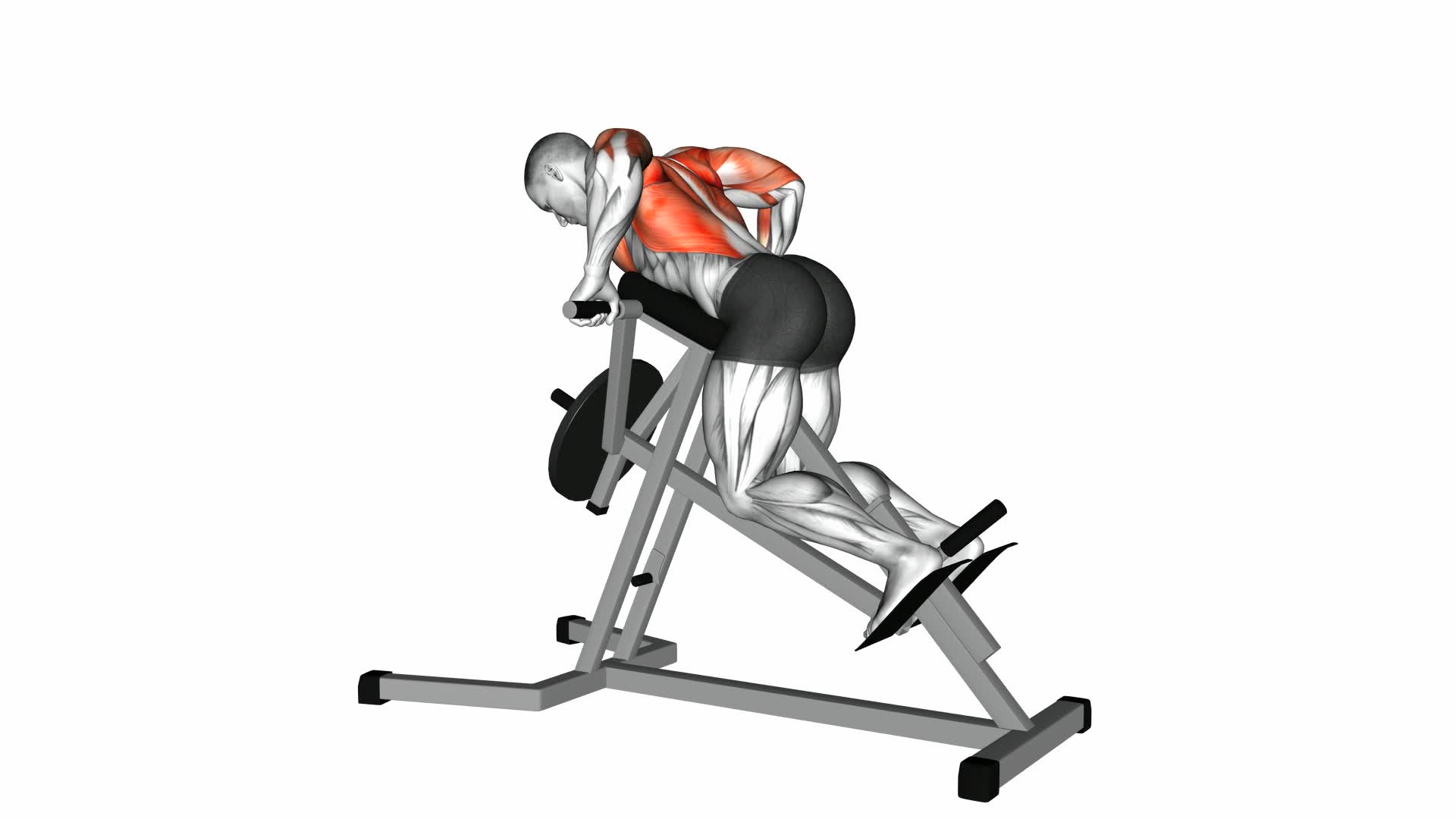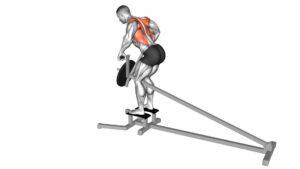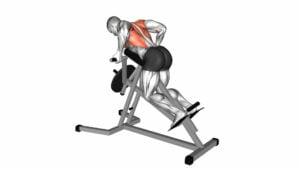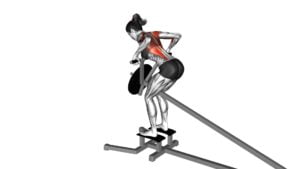Lever Lying T-bar Row – Video Exercise Guide & Tips

Are you looking to strengthen your back muscles?
Watch This Exercise Video
Check out this video exercise guide and tips for the Lever Lying T-bar Row. You'll learn the proper form and technique, as well as equipment and set-up recommendations.
With step-by-step execution instructions and common mistakes to avoid, this guide will help you maximize your results.
Plus, we'll share tips for progression and variation to keep your workouts challenging.
Get ready to take your back training to the next level!
Key Takeaways
- Engage your biceps, shoulders, and core muscles while performing the Lever Lying T-bar Row.
- Use proper form and technique, maintaining a neutral spine and contracting your core.
- Adjust the height of the chest support and position your feet on the footrests for optimal setup.
- Focus on targeting the back muscles, including the latissimus dorsi, rhomboids, and trapezius, to improve back strength and posture.
Proper Form and Technique
To perform the Lever Lying T-bar Row exercise with proper form and technique, start by positioning yourself on the lever lying T-bar row machine. One common misconception about this exercise is that it only targets the back muscles. In reality, it also engages the biceps, shoulders, and core muscles. By maintaining a neutral spine and contracting your core throughout the movement, you can ensure proper form and maximize the benefits of this exercise.
The Lever Lying T-bar Row offers several benefits and variations. It helps to strengthen and build the muscles of the upper back, including the lats, rhomboids, and traps. Additionally, it improves posture and enhances overall upper body strength. To add variety to your workout routine, you can try different grip variations such as overhand, underhand, or close grip. You can also increase or decrease the weight to challenge your muscles in different ways.
Now that you understand the proper form, technique, misconceptions, benefits, and variations of the Lever Lying T-bar Row exercise, let's move on to the next section where we'll discuss the equipment and set-up required for this exercise.
Equipment and Set-up
Now let's talk about the equipment and set-up for the Lever Lying T-bar Row exercise.
The Lever Lying T-bar Row is a versatile exercise that can be performed using various equipment options. The most common equipment used for this exercise is a T-bar row machine or a T-bar row attachment on a cable machine. These machines typically have a padded chest support and a lever with handles or a V-bar attached to it.
To set up for the Lever Lying T-bar Row, adjust the height of the chest support so that it aligns with your mid-chest. Place your chest against the pad and position your feet on the footrests for stability. Grab the handles or V-bar with an overhand grip, slightly wider than shoulder-width apart.
The Lever Lying T-bar Row offers several benefits, including targeting the muscles of the back, such as the latissimus dorsi and rhomboids, as well as the biceps and forearms. It also helps improve upper body strength and posture.
There are variations of the Lever Lying T-bar Row that can be done using different equipment or grips. Some variations include using a close grip or an underhand grip, as well as performing the exercise with free weights such as a barbell or dumbbells. These variations can add variety and target different muscle groups within the back.
Remember to consult with a fitness professional before attempting new exercises and always use proper form and technique to prevent injury and maximize the benefits of the Lever Lying T-bar Row.
Muscles Targeted
Now let's talk about the muscles targeted during the Lever Lying T-bar Row.
This exercise primarily works your back muscles, including the latissimus dorsi, rhomboids, and trapezius.
It also engages the biceps, rear deltoids, and forearms.
To maximize the effectiveness of this exercise, focus on maintaining proper form and engaging your target muscles throughout the movement.
Key Targeted Muscles
Engage your back muscles with the lever lying T-bar row exercise. This exercise targets several muscle groups in your back, including the latissimus dorsi, rhomboids, and trapezius.
The latissimus dorsi, or lats, are the largest muscles in your back and are responsible for pulling movements. The rhomboids help retract and stabilize the scapula, while the trapezius muscles assist in scapular elevation and depression. By targeting these muscles, the lever lying T-bar row helps improve your overall back strength and posture.
In addition to building muscle, this exercise also offers training benefits such as increased grip strength and improved upper body stability.
Now that you know which muscles are targeted, let's move on to some proper form tips to ensure you get the most out of this exercise.
Proper Form Tips
To properly target the muscles in your back during the lever lying T-bar row exercise, focus on maintaining a strong and stable posture throughout the movement. This will ensure that you're effectively engaging the targeted muscles and avoiding common mistakes.
One common mistake is rounding your back, which not only reduces the effectiveness of the exercise but also puts unnecessary strain on your spine. Instead, keep your back straight and your chest lifted throughout the entire movement.
Another important tip for proper form is to avoid using momentum to perform the exercise. Instead, focus on controlled and deliberate movements, pulling the weight towards your chest and squeezing your shoulder blades together.
As you progress with the exercise, you can increase the weight gradually to continue challenging your muscles.
Step-by-Step Execution
Now, let's take a closer look at the step-by-step execution of the Lever Lying T-bar Row.
This exercise is all about proper form, so pay close attention to the demonstration.
It's important to avoid common mistakes that can hinder your progress, so we'll also highlight those to keep you on track.
Proper Form Demonstration
Begin by positioning yourself in front of the lever lying T-bar row machine. To perform the exercise with proper form, start by gripping the handles with an overhand grip, slightly wider than shoulder-width apart. Keep your back straight and knees slightly bent. Pull the handles towards your midsection, squeezing your shoulder blades together.
As you pull, focus on using your back muscles rather than relying on your arms. Keep your core engaged throughout the movement to maintain stability. The Lever Lying T-bar Row offers several benefits, including targeting your upper back muscles, improving posture, and enhancing overall strength and stability. By performing this exercise correctly, you can maximize its effectiveness and minimize the risk of injury.
Now let's move on to the next section to learn about common mistakes to avoid.
Common Mistakes to Avoid
Avoid these common mistakes to ensure proper execution of the Lever Lying T-bar Row exercise and maximize its effectiveness and safety.
- One common mistake is using too much weight. It's important to start with a weight that allows you to maintain proper form throughout the exercise.
- Another mistake is rounding your back. Keep your back straight and engage your core to prevent strain on your lower back.
- Additionally, avoid pulling with your arms instead of your back muscles. Focus on squeezing your shoulder blades together and using your back muscles to initiate the movement.
- Lastly, don't rush the exercise. Take your time and perform each rep with control and precision.
Common Mistakes to Avoid
To perform the Lever Lying T-bar Row correctly, avoid rounding your back during the exercise. Maintaining proper form is crucial to prevent injuries and maximize the benefits of this exercise. Here are some common mistakes to avoid:
- Rounding your back: This is the most common mistake people make during the Lever Lying T-bar Row. It puts excessive stress on your spine and can lead to back pain. Keep your back straight throughout the movement to engage your back muscles effectively.
- Using momentum: Swinging your body or using momentum to lift the weight takes away the focus from the targeted muscles. Instead, perform the exercise in a controlled manner, using your back muscles to pull the weight towards you.
- Gripping the handles too tightly: Holding the handles too tightly can cause tension in your forearms and wrists, taking away from the engagement of your back muscles. Maintain a firm but relaxed grip throughout the exercise.
- Not fully extending your arms: Failing to fully extend your arms at the bottom of the movement limits the range of motion and reduces the effectiveness of the exercise. Make sure to fully straighten your arms before pulling the weight towards your chest.
Tips for Progression and Variation
To continually challenge yourself and avoid plateauing, incorporate different variations of the Lever Lying T-bar Row into your routine. By incorporating progression techniques and variation ideas, you can keep your workouts fresh and continue to see improvements in strength and muscle development.
One way to progress with the Lever Lying T-bar Row is by increasing the weight or resistance. Start with a weight that challenges you but still allows you to maintain proper form. As you become more comfortable, gradually increase the weight to continue challenging your muscles.
Another progression technique is to change the grip. Instead of using the traditional overhand grip, try using an underhand grip or a neutral grip. This will target different muscles and add variety to your workout.
You can also vary the tempo of your reps. Slow down the eccentric (lowering) phase of the movement to increase time under tension and maximize muscle activation. Alternatively, you can perform explosive concentric (lifting) reps to improve power and explosiveness.
Additionally, consider incorporating different grip widths. A wider grip will target your upper back and lats, while a narrower grip will focus more on your biceps and middle back.
Incorporating these progression techniques and variation ideas will help you continually challenge your muscles and avoid hitting a plateau in your Lever Lying T-bar Row workouts.
Frequently Asked Questions
How Many Sets and Reps Should I Do for the Lever Lying T-Bar Row Exercise?
For optimal results with the lever lying T-bar row exercise, it's important to consider the number of sets and reps.
Start with 3 sets of 8-12 reps, using a weight that challenges you but allows for proper form.
As you progress, gradually increase the weight and aim for 3-4 sets of 10-15 reps.
Incorporating this exercise into a full body workout routine can help improve overall strength and muscle development.
Can I Use Dumbbells Instead of a Barbell for This Exercise?
Yes, you can use dumbbells instead of a barbell for the lever lying T-bar row exercise. The dumbbell variation offers several benefits.
It allows for a greater range of motion and helps to engage your stabilizer muscles. Additionally, using dumbbells can help correct any muscle imbalances and provide a different stimulus to your muscles.
Make sure to choose a weight that challenges you while maintaining proper form to maximize the benefits of using dumbbells.
Is It Necessary to Warm up Before Performing the Lever Lying T-Bar Row?
To prevent injuries and maximize your performance, it's highly recommended to warm up before doing the lever lying t-bar row. A proper warm-up prepares your muscles and joints for the exercise, reducing the risk of strains and sprains.
If you don't have access to the necessary equipment or prefer alternative exercises, consider incorporating dumbbell rows or cable rows into your routine.
Can This Exercise Be Modified for Individuals With Lower Back Issues?
For individuals with lower back issues, it's important to find alternative exercises that can still target the same muscle groups without causing further discomfort.
You'll want to focus on exercises that don't put excessive strain on the lower back.
Additionally, proper form and technique modifications can help alleviate stress on the lower back.
It's crucial to consult with a qualified fitness professional or physical therapist who can provide specific exercises and guidance tailored to your needs.
Are There Any Specific Breathing Techniques I Should Follow During This Exercise?
During the Lever Lying T-bar Row exercise, it's important to focus on your breathing technique. Controlled breathing can greatly benefit your strength training.
Remember to exhale as you pull the weight towards your chest and inhale as you return to the starting position. This helps engage your core and stabilize your body.
Proper breathing can improve your workout and prevent injury. Make sure to maintain a steady and controlled breathing pattern throughout the exercise.
Conclusion
In conclusion, the lever lying T-bar row is an effective exercise for targeting multiple muscles in the upper body. By maintaining proper form and technique, utilizing the appropriate equipment and set-up, and avoiding common mistakes, individuals can achieve optimal results.
Additionally, tips for progression and variation can help individuals continue to challenge themselves and make progress in their fitness journey. Incorporating this exercise into your routine can contribute to overall strength and muscle development.

Author
Years ago, the spark of my life’s passion ignited in my mind the moment I stepped into the local gym for the first time. The inaugural bead of perspiration, the initial endeavor, the very first surge of endorphins, and a sense of pride that washed over me post-workout marked the beginning of my deep-seated interest in strength sports, fitness, and sports nutrition. This very curiosity blossomed rapidly into a profound fascination, propelling me to earn a Master’s degree in Physical Education from the Academy of Physical Education in Krakow, followed by a Sports Manager diploma from the Jagiellonian University. My journey of growth led me to gain more specialized qualifications, such as being a certified personal trainer with a focus on sports dietetics, a lifeguard, and an instructor for wellness and corrective gymnastics. Theoretical knowledge paired seamlessly with practical experience, reinforcing my belief that the transformation of individuals under my guidance was also a reflection of my personal growth. This belief holds true even today. Each day, I strive to push the boundaries and explore new realms. These realms gently elevate me to greater heights. The unique combination of passion for my field and the continuous quest for growth fuels my drive to break new ground.







